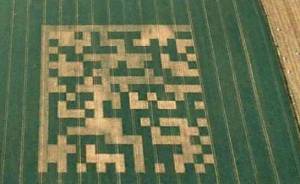We saw yesterday that ScanLife is running a “Crazy Code” photo contest to find the most brilliant, fresh and crazy place for a 2D bar code. The winner gets a new iPad. Just create a code, place it in your crazy place, snap a photo and send it in.
So in thinking about this, doesn’t everyone win when bar codes are used in new and interesting ways? Ok, that hurt just saying that.
But funny or not, the widespread acceptance of bar coding within industry over the past three decades has led to the development of numerous new applications that ensure easy asset identification and supply chain visibility that make every logistics manager a winner, right? Okay, okay no more.
So what are the benefits of barcoding? Here are a few:
Improved Data Accuracy
Improved data accuracy is the single most common motivation for implementing a bar code system. Often the backbone of operations, data entry enables a company to produce accurate reports and predictions about future needs and actions.
Efficiency Benefits
Besides providing near-perfect accuracy, bar coding also enables users to work faster, without sacrificing accuracy. When factoring in the time it takes to correct simple data entry errors, it is easy to see the improved efficiency that comes with bar coding. In addition, by providing computer systems the capability to “see” exactly what is happening within an organization, bar codes enable instant conversion from physical actions into digital transactions.
Consistency
Bar coding, particularly in fast-paced industrial environments, enables consistent and predictable operations for enhanced product quality by combining data management functions and preventing bottlenecks at data entry stations. Auto ID systems usually operate at a defined pace, either self-determined by the printer’s maximum speed or triggered by the action of another device.
Improved Inventory and Asset Management
Bar coding can help any company get a handle on resources. Companies are routinely bar coding assets such as manufacturing equipment, computer hardware, office furniture, and tools in order to record the number of each item, as well as the condition, color, features, and designated user. Libraries around the world are starting to place bar codes on books to track borrowing history. Likewise, automotive fleet owners, public transportation agencies, and rental car companies have begun utilizing bar codes to track detailed maintenance records for each vehicle. Manufacturing companies have similar applications in place to track both resource and finished product inventories.
Don’t you feel like a winner already?
It is widely thought that most Auto ID systems pay for themselves in less than two years, but this figure is dependent on a company’s commitment to widespread implementation and acceptance of the bar coding technology. In addition to the savings, each of these areas also produces several hidden savings that must be considered during the cost analysis, though the answers may not surface until the implementation is complete.
Once the data entry on the production line is automated, can production be sped up? If we create unique bar codes for each product, can the company fulfill customized solutions? Once inventory is monitored in real time, can we trim warehousing costs? These are just a few examples of the hidden gains resulting from bar coding. Several other opportunities will emerge as the use of Auto ID gains synthesis with operations.
You can learn more about bar coding here.
